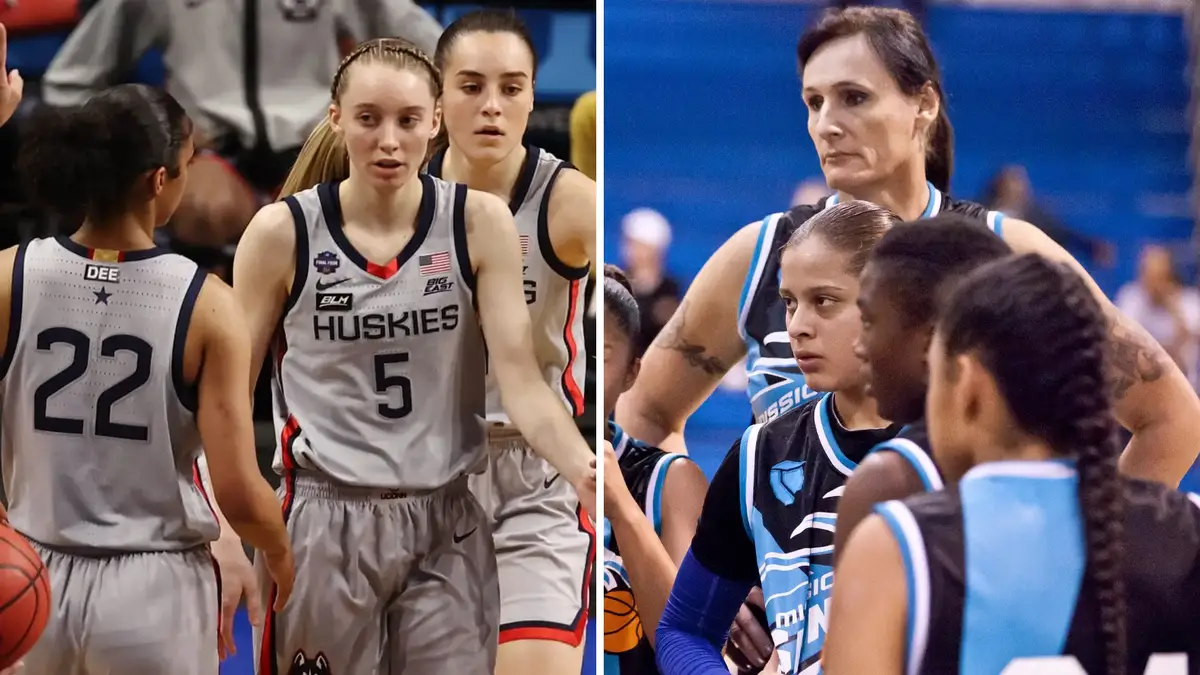Standing Firm: The Fight for Fairness in Girls’ Basketball
Introduction
In an era where inclusivity and fairness in sports are being hotly debated, a recent controversy involving a girls’ basketball team refusing to compete against biological males has reignited discussions about gender, competition, and equity in athletics. The team’s stance—declaring that “it’s not fair”—raises significant questions about the integrity of women’s sports, the role of biological differences in competition, and the policies governing transgender athletes’
This essay explores the implications of this decision, the scientific and ethical debates surrounding transgender athletes in women’s sports, and the broader societal impact of enforcing or resisting such policies. By examining the perspectives of athletes, coaches, parents, and experts, we can better understand the complex nature of fairness in sports and the potential solutions that could ensure both inclusion and competitive integrity.

Historical Context of Women’s Sports
Women’s sports have been historically marginalized, with female athletes fighting for recognition, funding, and opportunities to compete on equal footing with their male counterparts. The passage of Title IX in 1972 was a landmark moment in U.S. sports history, ensuring that schools provide equal athletic opportunities for female athletes.
The intention behind Title IX was to prevent discrimination and to empower young women in competitive sports. Over the decades, this law has resulted in a dramatic increase in female participation in sports, providing countless opportunities for scholarships, professional careers, and personal growth. However, the modern debate over transgender participation in women’s sports has sparked new concerns about whether the hard-fought gains of female athletes are being compromised.
The Science of Biological Differences in Athletics
The primary argument against allowing biological males to compete in girls’ and women’s sports stems from the well-documented physiological differences between males and females. Studies have shown that biological males, due to testosterone and puberty-driven advantages, generally have greater muscle mass, bone density, cardiovascular capacity, and strength compared to females. Even after hormone therapy, many of these advantages remain, giving transgender women a potential competitive edge.
For example, research has shown that male athletes generally have:
- Greater lung capacity and oxygen efficiency.
- Higher levels of fast-twitch muscle fibers, contributing to speed and explosiveness.
- Increased grip strength and upper body muscle mass.
While supporters of transgender inclusion argue that hormone therapy reduces competitive advantages, critics counter that many of these physical attributes cannot be fully reversed, which is why separate divisions for men and women exist in the first place.
Fairness and Competitive Integrity in Women’s Sports

The decision of the girls’ basketball team to forfeit their game against a team with a transgender player is rooted in the belief that fairness is being undermined. For these athletes, the concern is not about excluding individuals based on identity, but rather ensuring that competition remains equitable.
Basketball, like many sports, relies on speed, strength, endurance, and agility. Even small differences in reaction time, height, or muscle strength can significantly impact game outcomes. Female athletes work hard to train and compete, and many argue that facing competitors with undeniable physical advantages negates the level playing field that women’s sports are supposed to provide.
Athletes from different disciplines have echoed these concerns. Female swimmers, track athletes, and MMA fighters have spoken out about the challenges of competing against biological males. In 2022, collegiate swimmer Riley Gaines voiced her frustration after competing against transgender athlete Lia Thomas, who had previously competed on the men’s team. Similar cases have arisen in track and field, cycling, and weightlifting, further fueling the debate.
The Emotional and Psychological Toll on Female Athletes
Beyond the physical disadvantages, there is a psychological and emotional toll on young female athletes who feel that their opportunities are being threatened. Many train for years with the hope of securing scholarships or achieving success in their sport, only to find themselves competing against athletes with inherent biological advantages.
For some, the issue extends beyond competition to a broader sense of justice and recognition. Young athletes want to be rewarded for their hard work and dedication, and many feel disheartened when faced with what they perceive as an unfair system. Some girls have expressed fears that speaking out against transgender inclusion in female sports will result in backlash, labeling, or ostracization.
The girls’ basketball team’s refusal to compete highlights this growing frustration. Their stand sends a message that fairness should not be compromised in the name of inclusivity. Instead, they argue, there should be solutions that respect both inclusivity and competitive integrity.

Policy Responses and Governing Bodies
Sports governing bodies worldwide have struggled to create policies that balance inclusivity and fairness. The NCAA, the International Olympic Committee (IOC), and the various high school athletic associations in the U.S. have implemented different policies on transgender participation, often facing criticism from both sides of the debate.
-
NCAA and High School Policies
The NCAA has revised its policies multiple times to accommodate transgender athletes while also considering competitive fairness. Some states have allowed transgender females to compete in women’s sports based on hormone suppression guidelines, while others have enacted bans on transgender athletes in female divisions. -
International Policies
The International Swimming Federation (FINA) has taken a stricter stance, barring transgender athletes who have undergone male puberty from competing in the female category. Other sports organizations, including World Rugby and the Union Cycliste Internationale (UCI), have also implemented policies to address concerns over fairness. -
Legal Battles and Political Involvement
The issue has become highly politicized, with state legislatures passing laws that either restrict or protect transgender participation in sports. Lawsuits have been filed on both sides, with some arguing that bans violate civil rights while others claim they protect women’s sports.
Potential Solutions: A Path Forward
Rather than an all-or-nothing approach, finding a balance between inclusion and fairness requires thoughtful policy adjustments. Some potential solutions include:
-
Creating an Open or Co-Ed Division
One possible compromise is establishing an “open” division where transgender and non-binary athletes can compete. This would allow for inclusivity without infringing on the integrity of women’s sports. -
Revising Eligibility Criteria Based on Physical Development
Instead of basing participation solely on gender identity, sports organizations could consider physiological markers such as testosterone levels, muscle mass retention, and bone density. This would help determine eligibility on a sport-by-sport basis. -
Improved Policy Transparency and Scientific Studies
More comprehensive studies on the impact of transgender participation in women’s sports could help shape fairer policies. Consistently evaluating scientific data and updating guidelines accordingly would help create a system that prioritizes both inclusion and fairness. -
Supporting Female Athletes Who Speak Out
Female athletes who express concerns about fairness should not be silenced or shamed. Respecting different perspectives and allowing open discussion will lead to better, more sustainable solutions.
Conclusion
The decision of a girls’ basketball team to refuse to compete against biological males is not an act of exclusion, but rather a stand for fairness. Their actions reflect a growing concern among female athletes who believe that their hard-earned opportunities should be preserved and protected.
As society navigates this complex issue, it is essential to respect both sides of the debate while ensuring that sports remain competitive, inclusive, and fair. The future of women’s sports depends on carefully crafted policies that honor the biological realities of competition while also promoting respect and inclusivity for all athletes.
Ultimately, fairness and integrity should remain at the core of any decision regarding sports participation. Finding a path forward requires thoughtful dialogue, scientific research, and policies that uphold the spirit of competition while acknowledging the voices of female athletes who seek a level playing field.
News
How did one North Carolina fan become the biggest story of the Clemson game without even stepping on the court? The answer will drop your jaw.
Social Media Has Fallen In Love With Jaw-Dropping North Carolina Fan Who Stole The Show In The Stands During Loss…
VIDEO: Dillon Gabriel’s first move as Browns’ starter? A chilling, direct shot at Shedeur Sanders that has the entire NFL fanbase gasping.
VIDEO: Dillon Gabriel’s first move as Browns’ starter? A chilling, direct shot at Shedeur Sanders that has the entire NFL…
J.K. Rowling’s explosive comments spark a TOTAL OLYMPIC MELTDOWN! Ticket sales are in freefall, and the 2028 Games are on the brink of collapse. You won’t believe the chaos.
J.K. Rowling’s explosive comments spark a TOTAL OLYMPIC MELTDOWN! Ticket sales are in freefall, and the 2028 Games are on…
Bad Bunny fires a shocking warning shot to Super Bowl viewers who don’t understand him, mocking the “right-wing backlash” to his historic halftime show.
Bad Bunny fires a shocking warning shot to Super Bowl viewers who don’t understand him, mocking the “right-wing backlash” to…
BREAKING: Erika Kirk breaks her silence with a shocking message to the “fans” questioning her grief. You don’t know the whole story. The timeline you’re demanding doesn’t exist.
BREAKING: Erika Kirk breaks her silence with a shocking message to the “fans” questioning her grief. You don’t know the…
The NFL just made a massive mistake on live TV. The “script” for the Browns-Vikings game was accidentally revealed, and fans are losing their minds. You have to see the video.
The NFL just made a massive mistake on live TV. The “script” for the Browns-Vikings game was accidentally revealed, and…
End of content
No more pages to load












